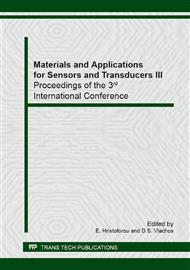p.107
p.111
p.115
p.119
p.123
p.127
p.131
p.135
p.139
A New Surface Modifying Material "Mercaptosilatrane" for Particle Plasmon Resonance Sensor
Abstract:
The self-assembled monolayer (SAM) of mercaptoalkoxysilane is wildly used as a molecular linker between metal and silica. The mercapto group is known to bond with many metals, including gold, silver, copper, and lead. The mercaptoalkoxysilane system, like 3-mercaptopropyltrimethoxysilane, usually uses a concentration of 100 mM and takes 12 h in methanol or 6 h in anhydrous organic solvent,[1-3] such as toluene and benzene, to form the SAM. Unfortunately, MPTMS is very sensitive to moisture,[4, 5] generally leading to agglomeration and polymerization on a substrate during deposition, and hence multilayer deposition and irregular surface morphology. Herein, a novel concept for preparing the mercaptosilane SAM via a precursor with a silatrane head-group is proposed. We have successfully synthesized mercaptopropylsilatrane (MPS) from mercaptopropylsilane and utilized it to modify the silica surface for immobilization of gold nanoparticles (AuNPs). Results show that at a low concentration (0.46 mM) of AuNPs in aqueous solution, a good surface coverage of AuNPs can be achieved in a short time (10 min).
Info:
Periodical:
Pages:
123-126
Citation:
Online since:
April 2014
Authors:
Keywords:
Price:
Сopyright:
© 2014 Trans Tech Publications Ltd. All Rights Reserved
Share:
Citation:


